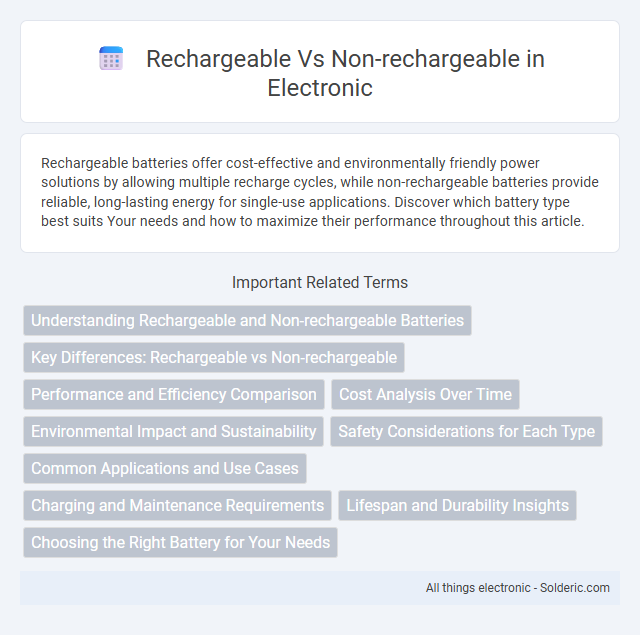Rechargeable batteries offer cost-effective and environmentally friendly power solutions by allowing multiple recharge cycles, while non-rechargeable batteries provide reliable, long-lasting energy for single-use applications. Discover which battery type best suits Your needs and how to maximize their performance throughout this article.
Comparison Table
| Feature | Rechargeable Batteries | Non-rechargeable Batteries |
|---|---|---|
| Usage Cycles | Multiple recharge cycles (hundreds to thousands) | Single-use, disposable after depletion |
| Cost Efficiency | Higher initial cost, cost-effective long term | Lower upfront cost, more expensive over time |
| Environmental Impact | Less waste, eco-friendlier | More waste, higher environmental burden |
| Energy Density | Moderate energy density | Higher energy density in some types |
| Self-discharge Rate | Higher self-discharge rate | Lower self-discharge rate |
| Common Applications | Electronics, power tools, electric vehicles | Remote controls, smoke detectors, clocks |
| Examples | Li-ion, NiMH, NiCd | Alkaline, Zinc-Carbon, Lithium primary |
Understanding Rechargeable and Non-rechargeable Batteries
Rechargeable batteries, such as lithium-ion and nickel-metal hydride (NiMH), can be recharged multiple times, offering long-term cost savings and environmental benefits. Non-rechargeable batteries, including alkaline and zinc-carbon types, provide a single-use power source with a higher initial energy density but generate more waste. Understanding the chemistry and usage cycles of these batteries helps choose the right option for devices based on power demands and sustainability preferences.
Key Differences: Rechargeable vs Non-rechargeable
Rechargeable batteries, such as lithium-ion and nickel-metal hydride, can be recharged multiple times, offering cost efficiency and environmental benefits over single-use alkaline or zinc-carbon non-rechargeable batteries. Rechargeable batteries feature higher upfront costs but provide longer overall lifespan and reduced waste, whereas non-rechargeable batteries are typically cheaper initially but require frequent replacements. Key differences include energy density, rechargeability, and chemical composition, with rechargeable batteries supporting sustainable usage patterns critical in modern electronics.
Performance and Efficiency Comparison
Rechargeable batteries offer superior performance in long-term use due to their ability to be recharged hundreds of times, making them more cost-effective and environmentally sustainable compared to non-rechargeable batteries. They typically provide consistent voltage output and better energy efficiency, whereas non-rechargeable batteries often deliver higher initial power but degrade faster and generate more waste. Efficiency metrics highlight that rechargeable lithium-ion and nickel-metal hydride batteries maintain over 80% charge retention across cycles, unlike alkaline disposable batteries that lose capacity quickly after a single use.
Cost Analysis Over Time
Rechargeable batteries have a higher upfront cost but provide significant savings over time due to their ability to be used multiple times, reducing the need for frequent replacements. Non-rechargeable batteries are cheaper initially but incur higher cumulative costs as they require constant repurchasing for devices with regular power consumption. Your best choice depends on the frequency of use and long-term financial considerations, where rechargeables offer greater cost efficiency for continuous or high-demand applications.
Environmental Impact and Sustainability
Rechargeable batteries significantly reduce environmental impact by minimizing waste and conserving resources compared to non-rechargeable batteries, which often end up in landfills due to single-use design. Your choice to use rechargeable batteries supports sustainability by lowering the demand for raw materials and decreasing greenhouse gas emissions associated with manufacturing and disposal. Emphasizing rechargeable options fosters long-term resource efficiency and a smaller ecological footprint.
Safety Considerations for Each Type
Rechargeable batteries require careful handling to avoid risks of overheating, leakage, or explosion due to overcharging or improper use, making safety features like built-in protection circuits essential. Non-rechargeable batteries pose less risk of overheating but can leak corrosive materials if stored improperly or used beyond expiration, which may damage devices and harm users. Understanding these safety considerations helps you choose the most appropriate battery type for your device while minimizing hazards.
Common Applications and Use Cases
Rechargeable batteries are commonly used in devices such as smartphones, laptops, electric vehicles, and power tools due to their cost-efficiency and environmental benefits over multiple charge cycles. Non-rechargeable batteries are preferred for low-drain devices like remote controls, smoke detectors, and medical equipment where long shelf life and consistent energy output are critical. You should choose rechargeable batteries for frequent use and high power demands, while non-rechargeable batteries are ideal for occasional or emergency applications.
Charging and Maintenance Requirements
Rechargeable batteries require regular charging using compatible chargers, enabling multiple usage cycles and reducing waste. Non-rechargeable batteries, also known as primary cells, cannot be recharged and must be replaced once depleted, leading to higher long-term costs and environmental impact. Maintenance for rechargeable batteries includes monitoring charge levels and avoiding overcharging, whereas non-rechargeable batteries need no charging but require proper disposal to prevent leakage and environmental damage.
Lifespan and Durability Insights
Rechargeable batteries offer a longer lifespan as they can be used hundreds of times before depleting, making them more durable and cost-effective for continuous use. Non-rechargeable batteries provide a limited single-use lifespan, often exhausting faster under high-drain devices, which reduces durability overall. Choosing rechargeable options for your devices ensures consistent performance and reduces waste, optimizing both lifespan and sustainability.
Choosing the Right Battery for Your Needs
Selecting the right battery involves evaluating the pros and cons of rechargeable and non-rechargeable options based on usage frequency and device power requirements. Rechargeable batteries, such as lithium-ion or NiMH, offer long-term cost savings and environmental benefits for high-drain devices or frequent use. Non-rechargeable batteries, like alkaline or lithium primary cells, provide higher initial energy density and longer shelf life, making them ideal for low-drain or emergency applications.
Rechargeable vs Non-rechargeable Infographic

 solderic.com
solderic.com